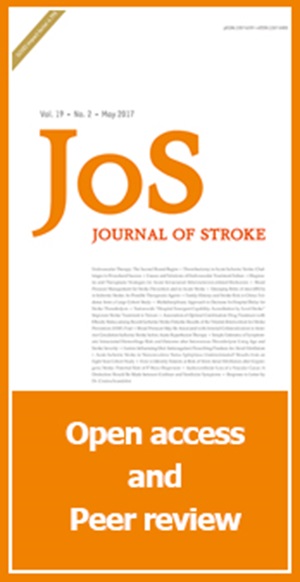Inpatient Outcomes of Cerebral Venous Thrombosis in Patients With Malignancy Throughout the United States.
IF 8.6
1区 医学
Q1 CLINICAL NEUROLOGY
引用次数: 0
Abstract
Background and Purpose Cerebral venous thrombosis (CVT) is associated with a high degree of morbidity and mortality. Our objective is to elucidate characteristics, treatments, and outcomes of patients with cancer and CVT (CA-CVT). Methods The 2016-2019 National Inpatient Sample (NIS) database was queried for patients with a primary diagnosis of CVT. Patients with a currently active diagnosis of malignancy (CA-CVT) were then identified. Demographics and comorbidities were compared between CA-CVT and CVT patients. Subgroup analyses explored patients with hematopoietic cancer and non-hematopoietic cancers. Stroke severity and treatment were explored. Inpatient outcomes studied were discharge disposition, length of stay, and mortality. Results Between 2016 and 2019, 6,140 patients had a primary diagnosis code of CVT, and 370 (6.0%) patients had a coexisting malignancy. The most common malignancy was hematopoietic (n=195, 52.7%), followed by central nervous system (n=40, 10.8%), respiratory (n=40, 10.8%), and breast (n=40, 10.8%). These patients tended to be older than non-CA-CVT and were more likely to have coexisting comorbidities. CA-CVT patients had higher severity scores on the International Study of Cerebral Vein and Dural Sinus Thrombosis Risk Score (ISCVT-RS) and increased complications. In a propensity-score matched cohort, there were no differences in inpatient outcomes. Conclusion Malignancy occurs in 6% of patients presenting with CVT and should be considered a potential comorbidity in instances where clear causes of hypercoagulabilty have not been identified. Malignancy was linked to higher mortality rates. Nonetheless, after adjusting for the severity of CVT, the outcomes for inpatients with cancer-associated CVT were comparable to those without cancer, indicating that the increased mortality associated with malignancy is probably due to more severe CVT conditions.全美恶性肿瘤患者脑静脉血栓的住院治疗结果。
背景和目的脑静脉血栓(CVT)与高发病率和高死亡率相关。我们的目的是阐明癌症合并 CVT(CA-CVT)患者的特征、治疗方法和预后。方法查询 2016-2019 年全国住院患者样本(NIS)数据库,寻找主要诊断为 CVT 的患者。然后确定了目前正在进行恶性肿瘤诊断(CA-CVT)的患者。比较了 CA-CVT 和 CVT 患者的人口统计学特征和合并症。对造血癌症和非造血癌症患者进行了分组分析。研究还探讨了中风的严重程度和治疗方法。研究的住院结果包括出院处置、住院时间和死亡率。结果2016年至2019年间,6140名患者的主要诊断代码为CVT,370名(6.0%)患者合并有恶性肿瘤。最常见的恶性肿瘤是造血系统恶性肿瘤(195人,占52.7%),其次是中枢神经系统恶性肿瘤(40人,占10.8%)、呼吸系统恶性肿瘤(40人,占10.8%)和乳腺恶性肿瘤(40人,占10.8%)。这些患者的年龄往往比非CA-CVT患者大,而且更有可能合并其他疾病。CA-CVT患者在脑静脉和硬脑膜窦血栓形成国际研究风险评分(ISCVT-RS)中的严重程度得分更高,并发症也更多。在倾向分数匹配队列中,住院患者的预后没有差异。结论6%的CVT患者患有恶性肿瘤,在高凝血功能障碍的病因尚未明确的情况下,恶性肿瘤应被视为一种潜在的合并症。恶性肿瘤与较高的死亡率有关。尽管如此,在对 CVT 的严重程度进行调整后,癌症相关 CVT 住院患者的预后与非癌症患者相当,这表明恶性肿瘤导致的死亡率升高可能是由于 CVT 病情更为严重所致。
本文章由计算机程序翻译,如有差异,请以英文原文为准。
求助全文
约1分钟内获得全文
求助全文
来源期刊

Journal of Stroke
CLINICAL NEUROLOGYPERIPHERAL VASCULAR DISE-PERIPHERAL VASCULAR DISEASE
CiteScore
11.00
自引率
3.70%
发文量
52
审稿时长
12 weeks
期刊介绍:
The Journal of Stroke (JoS) is a peer-reviewed publication that focuses on clinical and basic investigation of cerebral circulation and associated diseases in stroke-related fields. Its aim is to enhance patient management, education, clinical or experimental research, and professionalism. The journal covers various areas of stroke research, including pathophysiology, risk factors, symptomatology, imaging, treatment, and rehabilitation. Basic science research is included when it provides clinically relevant information. The JoS is particularly interested in studies that highlight characteristics of stroke in the Asian population, as they are underrepresented in the literature.
The JoS had an impact factor of 8.2 in 2022 and aims to provide high-quality research papers to readers while maintaining a strong reputation. It is published three times a year, on the last day of January, May, and September. The online version of the journal is considered the main version as it includes all available content. Supplementary issues are occasionally published.
The journal is indexed in various databases, including SCI(E), Pubmed, PubMed Central, Scopus, KoreaMed, Komci, Synapse, Science Central, Google Scholar, and DOI/Crossref. It is also the official journal of the Korean Stroke Society since 1999, with the abbreviated title J Stroke.
 求助内容:
求助内容: 应助结果提醒方式:
应助结果提醒方式:


